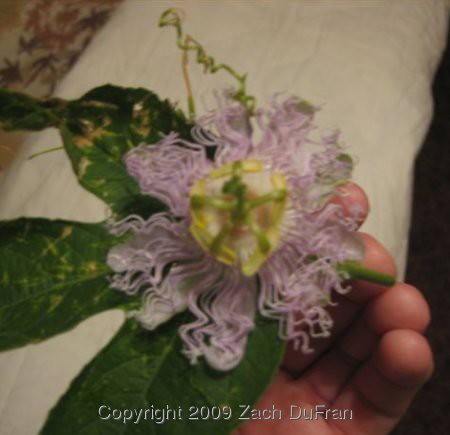My family heads down to Lake Texoma (on Oklahoma's southern border) on the weekends during the Summer, to ride around the lake on our boat and waterski. There is a nearby area we like to call "Jurassic Park" because of its thick vegetation. We drive in on a golf cart and forget that we are in the central United States. You almost feel like you are in a South American jungle, unless you look closely at the type of plants growing. Looking at the vegetation, I never saw anything spectacular (in the tropical sense). That is, until recently.
The picture below is of a Passionflower bloom that I cut off of a plant growing wild in "Jurassic Park," about 100 yards from the waters of Lake Texoma. It is unlikely that this plant was growing there natively, but it is also unlikely that it was planted. My guess is that somewhere nearby this plant is in someone's garden and a bird ate from the fruit and deposited the seed in this location.
I have heard people talk about how hardy Passionflowers can be very invasive in our climate. The first year the plant is beautiful and robust and the next year there are plants coming up everywhere. But I hadn't seen this in person, so, like Thomas, I doubted. Now I have seen some of this Passionflower growing wild in a very unexpected location. This area was the last place I expected to see a beautiful flower that looks so tropical. The plants were covering much of the undergrowth and were bearing fruits in many areas. Once you saw one, you would see tens of them. Your eyes just had to be attuned.
I immediately wanted to bring some of this plant home with me. First, I tried digging up some of the smaller plants and bringing them home with me, but it was very difficult to dig up the plants and bring the roots along. The plants died within a matter of days. To add injury to insult, I ended up covered in poison ivy that lasted for several weeks. It was miserable.
A couple of weeks later, against the recommendations of all of my family members, I went back to take cuttings of these plants. This time I was very wary of the poison ivy and stayed free of it. The cuttings stayed green for a couple of weeks and I held out hope that they would produce roots, but none of them did and eventually the cuttings withered and died.
If you happen to have a tip for taking cuttings of Passionflowers, I would love to hear it.
The picture below is of a Passionflower bloom that I cut off of a plant growing wild in "Jurassic Park," about 100 yards from the waters of Lake Texoma. It is unlikely that this plant was growing there natively, but it is also unlikely that it was planted. My guess is that somewhere nearby this plant is in someone's garden and a bird ate from the fruit and deposited the seed in this location.
 |
| Passiflora incarnata bloom, cut from plants growing wild in southern Oklahoma |
I immediately wanted to bring some of this plant home with me. First, I tried digging up some of the smaller plants and bringing them home with me, but it was very difficult to dig up the plants and bring the roots along. The plants died within a matter of days. To add injury to insult, I ended up covered in poison ivy that lasted for several weeks. It was miserable.
A couple of weeks later, against the recommendations of all of my family members, I went back to take cuttings of these plants. This time I was very wary of the poison ivy and stayed free of it. The cuttings stayed green for a couple of weeks and I held out hope that they would produce roots, but none of them did and eventually the cuttings withered and died.
If you happen to have a tip for taking cuttings of Passionflowers, I would love to hear it.
Wild passions! These are very exotic looking. Here's a link to a monograph I found online by Stephen Foster. He discusses propagation:
ReplyDeletehttp://www.stevenfoster.com/education/monograph/pflower.html
Good luck with that, and watch out for the poison ivy!
How very pretty. Passion flowers are one of my favorites. There are so many lovely varieties!
ReplyDeleteMaybe you can get someone to send you seeds. I don't grow them in my garden, but they are in wild areas nearby and butterflies from them do come to nectar in my garden.
ReplyDeleteWhen I was a child, we called them 'maypops' and they were considered a field weed.
Wow! Passionflowers growing wild in Oklahoma! I'll ask my husband if he knows the lake and "Jurassik park". Sorry you got in trouble with an evil ivy!
ReplyDeleteI can get for you the wild ones in my place. The flower is rather very small & they give out yellow fruit.
ReplyDeleteits known as Bush Passion Fruit or Running Pop (Passiflora Foetida)
Do check my blog on this:
http://jamesmissier.blogspot.com/search/label/Passiflora
The red seeded plant is Alocasia - do let me know if you are interested in those.
This plant is native to Oklahoma. I collect Pasiflora all over Eastern Oklahoma. I dry the leaves and stems then crush it up for tea. Pasiflora Tea is a natural muscle relaxer and is commonly used in Europe. The tea is great for female cramps.
ReplyDeleteLauren, I didn't know Passiflora leaves were used for teas. Very cool! What species have you used?
ReplyDelete